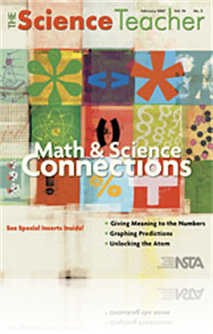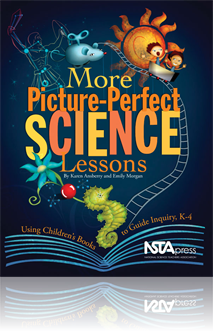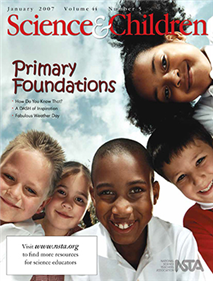All Resources
Journal Article
Science Sampler: A “handy” way to teach classification
When teaching the five kingdoms to middle school students, use this “handy” mnemonic device that helps students recall kingdom names, as well as a fact or two about each one. Simple and obvious analogies are used to captivate and retain students�...
Journal Article
Scope on Safety: Dissection—Don’t cut out safety
In June 2005, the NSTA Board of Directors adopted a revised position statement, Responsible Use of Live Animals and Dissection in the Science Classroom. Under the “Dissection” section, NSTA calls for more research to determine the effectiveness o...
Journal Article
Science Sampler: Recycling aluminum cans in the lab—Two inexpensive inquiry activities
Don’t throw away that aluminum can! Don’t even place it in the recycling bin. Instead, use it in your next science lab. In addition to the economic advantages of using materials such as aluminum cans, there are also pedagogical advantages: Physic...
Journal Article
Using Web-Based Simulations to Promote Inquiry
Science teachers seek engaging, effective, and inquiry-based activities that are standards-aligned and convenient to implement in their classrooms. For many years, the web has provided teachers and students with a vast resource of factual information...
Journal Article
Resourceful Science Integration
Recognizing that many issues of Science and Children contain helpful and varied examples of science integration that might be pertinent to a particular classroom setting, we decided to compile an annotated bibliography using issues from the last 12 y...
Journal Article
Of all the disciplines, mathematics would seem to be the easiest to connect with science. After all, mathematics is the “the language of science.” We already use math to analyze data and solve problems in science classes; efforts to intentionally...
Journal Article
Cheep, Chirp, Twitter, & Whistle
In this article, we describe an interdisciplinary, activity-based lesson plan implemented in a third/fourth-grade classroom. During these activities, students use musical concepts to think about, illustrate, and discuss animal behavior, and they us...
Journal Article
Science Sampler: Making the most of limited lab facilities
Despite less-than-adequate lab facilities, it is possible to come up with creative ways to provide your students with quality, lab-based activities. These strategies include the use of basket labs, progressive hand-rinsing stations, microscaling, mod...
Journal Article
Science Sampler: The SI system on the basketball court
For many students, the metric system of SI units is so complex that it is shifted into the realm of the mystical and then forgotten. Here is a fun and easy inquiry-based activity to familiarize your students with the SI system using your school’s b...
Journal Article
Idea Bank: Effective Data Representation
Science students often have a difficult time distinguishing between data collection and data representation and interpretation. It is important for students to understand that organizing data into a chart or graph can often lead to identifying relati...
Journal Article
The Early Years: Birds in Winter
Science and art go hand-in-hand, as scientists make art to share their observations. Two scientists who are widely known first as artists are Leonardo de Vinci, anatomist and inventor, and Beatrix Potter, mycologist. Both of these scientists used obs...
Journal Article
Learning makes more sense and is retained when it has a context and connection to other knowledge. We know this from a wealth of sources: research, our experiences as students—and as teachers. We remember things that have a rich set of connections....
Journal Article
Perspectives: Connecting with Other Disciplines
Interdisciplinary instruction is a way of approaching curriculum by organizing content and processes from more than one discipline around a central theme, issue, problem, topic, or experience (Jacobs 1989). Teachers can start the process of designing...
Journal Article
Editor’s Roundtable: Never cut corners on safety
Teaching science in a less-than-adequately equipped room is unsafe and just plain dangerous. Where safety is concerned, there are no shortcuts, no make-do techniques that Science Scope authors or anyone else can offer you. School districts must pro...
Book Chapter
As stated in “About This Book,” the author isn’t going to take the usual approach to the subject of chemistry. Because virtually all explanations of chemical reactions are based on our current model of atoms and molecules, the first thing to do...
Book Chapter
At the end of the first chapter, you realized, hopefully, that the model of an atom that we have so far (Rutherford’s model of a concentrated positive nucleus with negative charges around it) doesn’t go very far in helping us explain observations...
Book Chapter
In thinking about a title for this chapter, the word periodicity came to mind. I was sure this had some kind of pop culture reference. After discussing this with my wife, we figured I was thinking of synchronicity, which is a reference to music b...
Book Chapter
Let’s Get Together … Yeah, Yeah, Yeah
Ah yes, the theme song from one of the strangest movies of all time—Parent Trap. The original, that is, with Hayley Mills. I was in love with her back then. So naturally, I would choose that phrase to title a chapter on how atoms combine to form mo...
Book Chapter
We now know enough about atoms and how they combine to investigate a number of different chemical reactions. We’ll even be able to represent those reactions with symbols that tell us how many of each kind of atom we begin with and how many of each ...
Book Chapter
The word organic has lots of meanings in everyday life. Organic vegetables are ones grown without pesticides and organic beef comes from cattle that haven’t been given antibiotics. When it comes to chemistry, organic sometimes means something el...
NSTA Press Book
Chemistry Basics: Stop Faking It! Finally Understanding Science So You Can Teach it
Do the words “periodic table” send chills down your spine? Are you anxious about atomic structure? Confounded by chemical equations? Relax! The cure for chemistry confusion is within reach, courtesy of this newly available book in the Stop Faking...
By William C. Robertson, Ph.D.
NSTA Press Book
More Picture-Perfect Science Lessons: Using Children’s Books to Guide Inquiry, K-4
Teachers raved when NSTA Press published Picture-Perfect Science Lessons .* They loved its lively mix of kid-magnet books, Standards-based science content and ready-to-teach lessons. So what could be more perfect? More Picture-Perfect Science Lesso...
By Karen Ansberry, Emily Morgan
eBook
More Picture-Perfect Science Lessons: Using Children’s Books to Guide Inquiry, K-4 (e-book)
Teachers raved when NSTA Press published Picture-Perfect Science Lessons in 2005.* They loved its lively mix of kid-magnet books, Standards-based science content and ready-to-teach lessons. So what could be more perfect? More Picture-Perfect Scien...
eBook
Chemistry Basics: Stop Faking It! Finally Understanding Science So You Can Teach it (e-Book)
Do the words “periodic table” send chills down your spine? Are you anxious about atomic structure? Confounded by chemical equations? Relax! The cure for chemistry confusion is within reach, courtesy of this newly available book in the Stop Faking...
Journal Article
Because supplies are limited in many classrooms, opaque film canisters can be used in a number of scientific inquiry activities, including a “black box” activity and several activities on sinking and floating properties related to density and to ...
Journal Article
The use of portfolios has had a positive impact on students, faculty, and the program in the Chemistry Department at Berea College. The portfolio allows for the inclusion in the curriculum of activities that occur outside of the classroom and offers ...
Journal Article
Understanding cyclic patterns and distinguishing them from other patterns is critical to understanding the Earth and beyond. Whether you are discussing star cycles, rock cycles, life cycles, or carbon cycles, this is the stuff of science. It is a fun...
Journal Article
The Early Years: Light Foundations
The day-and-night cycle forms the basis for understanding many other natural cycles in plants, animals, and Earth processes, as well as later learning about the solar system, and it is part of the National Science Education Content Standard D, Earth ...










